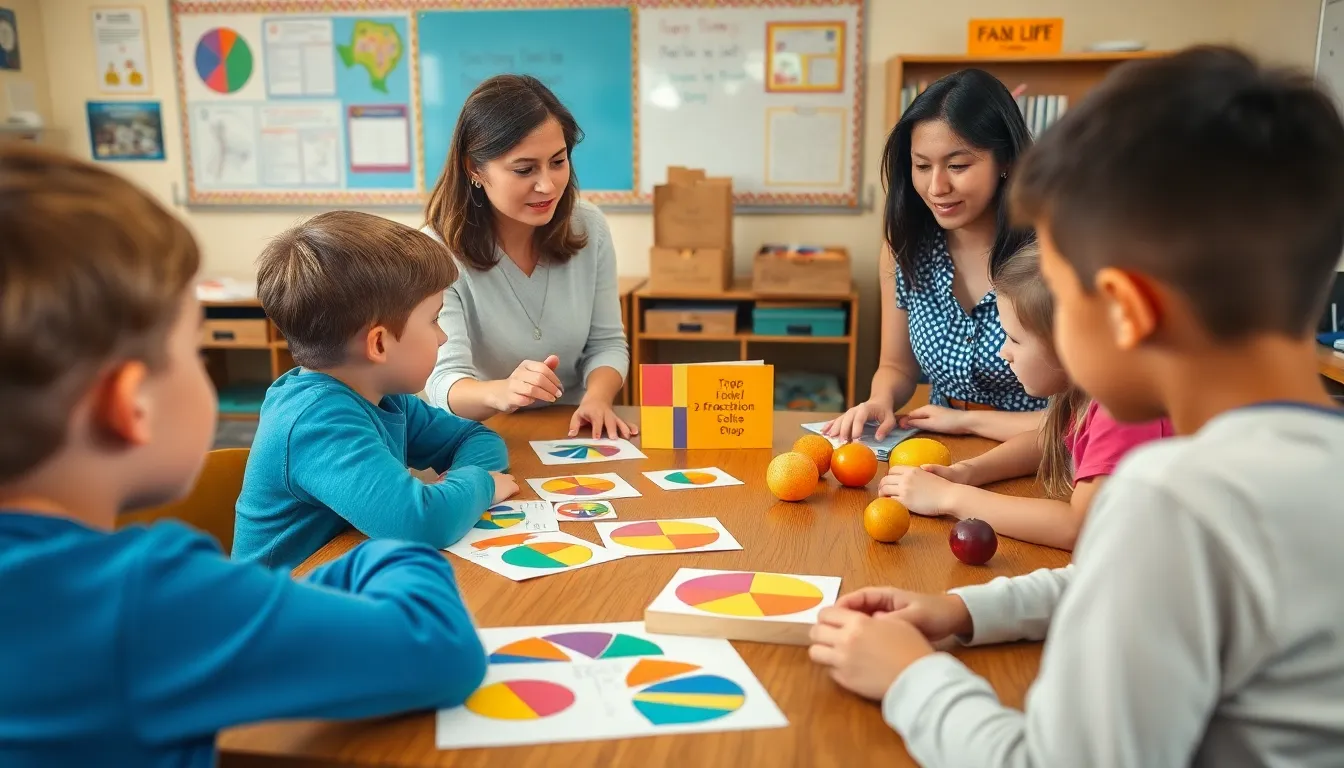When it comes to measurements, few combinations are as intriguing as 1/2 x 2. This seemingly simple equation packs a punch that can transform your understanding of fractions and multiplication. It’s like finding out your favorite snack comes in a double serving—who wouldn’t want that?
Table of Contents
ToggleOverview of 1/2 x 2
The expression 1/2 x 2 represents a straightforward multiplication involving a fraction. This equation highlights how fractions interact with whole numbers, specifically demonstrating that half of a quantity multiplied by two results in the original quantity. For example, taking 1/2 of an apple and then multiplying that by two perfectly brings back one whole apple.
Seeing 1/2 x 2 as a mathematical representation offers insight into the concept of scaling. Scaling refers to increasing or decreasing a quantity, and this equation illustrates doubling the half. As a result, students or learners often grasp the principle of fractions better when applying practical examples, like sharing food.
Exploring 1/2 x 2 not only cements understanding but also facilitates further exploration into more complex mathematical concepts. Areas such as ratios and proportions emerge strongly when engaging with the equation. For instance, recognizing that doubling a half efficiently illustrates the relationship between different quantities prepares individuals for advanced topics in math.
Teachers frequently utilize simple fractions as effective teaching tools. They create opportunities to connect with students through real-life scenarios. Dividing a pizza into halves and then doubling them serves as an excellent illustration. Such analogies provide context, making it easier for students to relate to their everyday experiences.
Lastly, visual aids reinforce the understanding of this equation. Drawing pie charts or using physical objects can clarify how 1/2 x 2 translates into a tangible concept. These methods encourage interaction and engagement, promoting a deeper appreciation for mathematical relationships.
Key Features of 1/2 x 2

This section highlights the essential aspects of the calculation 1/2 x 2. Focusing on material quality and design can enhance understanding and practical application.
Material Quality
The concept of 1/2 x 2 employs simple fractions, engaging learners effectively. Materials for teaching this equation often include visual aids like pie charts or manipulatives, providing tangible examples. Engaging students with physical objects, such as fruit, stems from this equation’s ability to normalize fractions. Quality materials encourage interaction and deepen comprehension. The tactile experience of handling objects reinforces abstract concepts. When students physically see 1/2 of an item and relate it to 2, they grasp the multiplication principle intuitively.
Design and Dimensions
Understanding the design of 1/2 x 2 enhances its application. In educational settings, layout influences effectiveness in conveying the concept. Simple illustrations or geometric shapes work best, promoting clarity. Dimensions of materials used should align with comfort for students, ensuring effective engagement. Standard measurement units, such as inches and centimeters, help create relatable examples. When structured correctly, design elements break down barriers, making fractions approachable. Incorporating engaging graphics defines the learning experience, fostering retention and understanding in students.
Applications of 1/2 x 2
The expression 1/2 x 2 finds varied applications across different fields. Understanding these applications enhances practical knowledge and mathematical fluency.
Industrial Uses
Numerous industries apply the concept of 1/2 x 2 in production processes. Manufacturing often relies on measuring materials, where taking half a quantity and doubling it is essential. A construction project, for instance, may require cutting beams into halves and using them for support structures. Logistics departments frequently employ this principle when distributing products, ensuring that quantities align with shipment requirements. Efficient inventory management utilizes 1/2 x 2 to forecast supply needs accurately. In quality control settings, being able to manipulate fractions enables precise assessments of product dimensions and tolerances, promoting higher standards in production.
DIY Projects
Many DIY projects also leverage the simplicity of 1/2 x 2 for effective results. Craft enthusiasts often use this calculation when measuring materials for various tasks. For instance, a woodworker might cut a 2-foot plank in half, then use both pieces for a table project, achieving the desired length and stability. Gardeners apply this fraction when spacing plants or laying out garden beds, ensuring equal distribution and growth. Home decorators benefit from understanding 1/2 x 2 while planning room layouts or furniture arrangements. Knowing how to divide and double measurements fosters creativity and efficiency in design endeavors, making projects more enjoyable and successful.
Benefits of Using 1/2 x 2
Utilizing 1/2 x 2 in education enhances comprehension of fractions and multiplication. Students grasp fundamental concepts more effectively when they practice with basic equations like this. Engaging with this operation fosters a sense of confidence in their mathematical abilities.
Demonstrating real-world applications solidifies learning. For instance, students learn practical uses in cooking and crafting by measuring ingredients like 1/2 cup or cutting materials into specific lengths. Connecting the equation with everyday tasks makes abstract concepts tangible.
Integrating visual aids further strengthens understanding. Teachers often use pie charts to illustrate how 1/2 x 2 results in a whole. When learners visualize these relationships, they often find it easier to remember fractions’ properties.
Incorporating hands-on activities encourages exploration. Manipulatives can help students physically work through problems, reinforcing the idea of doubling quantities. Such experiences often lead to greater retention of knowledge.
This calculation also holds significance in various industries. Manufacturing processes utilize 1/2 x 2 for efficient resource management. Understanding how to manipulate measurements can enhance productivity and reduce errors.
Beyond academic settings, DIY projects often benefit from applying this concept. Craft enthusiasts frequently require precise measurements for their projects. Knowing 1/2 x 2 can help ensure dimensions are accurate, resulting in better outcomes.
The ability to maneuver through simple fractions builds a foundation for more complex math. With 1/2 x 2, students can transition seamlessly into ratios and proportions. Early exposure to these principles encourages advanced problem-solving skills later on.
The exploration of 1/2 x 2 reveals its fundamental role in understanding fractions and multiplication. This simple equation not only reinforces basic math skills but also serves as a gateway to more complex concepts. By applying it to real-world scenarios like cooking and crafting, learners can see its practical value.
Additionally, the importance of quality teaching materials and engaging visuals cannot be underestimated. They play a crucial part in making abstract ideas more tangible. Mastery of 1/2 x 2 enhances confidence and fosters a deeper appreciation for mathematics, setting the stage for future learning and problem-solving. Embracing this concept opens doors to creativity and efficiency in various fields, making it an essential part of both education and practical applications.






